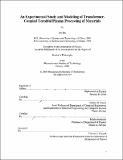| dc.contributor.advisor | Herbert H. Swain. | en_US |
| dc.contributor.author | Bai, Bo, Ph. D. Massachusetts Institute of Technology | en_US |
| dc.contributor.other | Massachusetts Institute of Technology. Dept. of Physics. | en_US |
| dc.date.accessioned | 2007-11-15T19:48:54Z | |
| dc.date.available | 2007-11-15T19:48:54Z | |
| dc.date.copyright | 2006 | en_US |
| dc.date.issued | 2006 | en_US |
| dc.identifier.uri | http://dspace.mit.edu/handle/1721.1/34975 | en_US |
| dc.identifier.uri | http://hdl.handle.net/1721.1/34975 | |
| dc.description | Thesis (Ph. D.)--Massachusetts Institute of Technology, Dept. of Physics, 2006. | en_US |
| dc.description | Includes bibliographical references (p. 287-304). | en_US |
| dc.description.abstract | The Transformer Coupled Toroidal Plasma (TCTP) source uses a high power density plasma formed in a toroidal-shaped chamber by transformer coupling using a magnetic core. The objectives of the thesis are (1) to characterize the TCTP source, (2) to understand the kinetics and limitations of species production by the remote TCTP source, and (3) to construct a generic model of plasma-surface interactions. By fitting the rovibrational bands of diatomic molecules such as N2, the temperatures of neutral gases were determined in the TCTP source. This was the first measurement of the neutral gas temperature of a high power density plasma in a toroidal geometry. An argon plasma was found to be around 2000K for a power density of 5 W/cm3. To avoid the necessity of N2 addition, the use of the C2 Swan bands of ( 3 3 d?g?a?u) were used to determine the neutral gas temperature of fluorocarbon plasmas. In a C2F6 discharge at a power density of 15 W/cm3, rotational and translational temperatures above 5000K were observed while vibrational temperatures above 8000K were found. The temperature measurements using C2 molecules were validated by the addition of N2 to the discharge and the caparison between the rotational temperatures of C2 and N2. These high neutral gas temperatures were justified by a power balance calculation that considered the thermal conduction, convection, ion bombardment, and dissociation energy losses. A linear dependence of the neutral gas temperature with the plasma power was found and is consistent with thermal and convention energy losses, where in both, the power loss linearly scales with the gas temperature. | en_US |
| dc.description.abstract | (cont.) The thesis systematically measured the dependence of plasma parameters, such as the neutral gas temperature, the electron temperature, the electron density and the species concentration, on the operational conditions of the plasma. A good match was observed between the experimental measurements and the rediction of a simplified global plasma model. The plasma model included the heating of the electron gas by a uniform electric field, the loss of energy from the gas to determine the electron temperature, ion and electron losses at surfaces, and formation and loss of species by the electron impact and surface recombination. The loss of atomic fluorine to the formation of COF2 was shown to cause the etching rate of oxide films in remote fluorocarbon plasmas to be about one half of that in the nitrogen trifluoride plasma since fluorine atoms are the major etchant of oxide. The addition of 3% N2 was shown to inhibit the formation of COF2 in perfluorocarbon discharges and thereby increase the amount of atomic fluorine supplied to the etching chamber. With the addition of N2, the etching rate of SiO2 and Si increased to rates that were comparable to that of NF3. The fluorocarbon gases were shown to be suitable for replacement of the nitrogen trifluoride for the remote plasma cleaning of chambers. In addition, the fluorocarbon plasmas with N2 addition were shown to possess low global warming gas emissions and clean surfaces (no carbonaceous contamination) after processing. The saturation of the etching rate of the silicon dioxide with the partial pressure of fluorine atoms was also observed for the first time. | en_US |
| dc.description.abstract | (cont.) In the saturation regime, the extent of F adsorption on the surface approaches its saturation limit and the etching rate is limited by the surface reaction of the adsorbed F with the surface. A new theoretical framework was developed to model the plasma surface kinetics of both etching and deposition processes for any plasma-surface interactions. The model is based on the translation of a mixed-layer on the substrate which is mixed by ion bombardment during the plasma processing. The kinetics of the etching and deposition are based on the assumption that the surface is atomically well mixed by ion bombardment, and therefore the number of any given moiety is computed by its corresponding nearest bonding neighbor probability, based on the elemental compositions of the layer. All major etching characteristics such as the dependence of the etching yield on the neutral to ion flux ratio can be explained by using the generic modeling approach. This model was also the first one to capture the angular dependence of the etching yield, as a result of the competition between the angular dependence of vacancy generation and that of ion induced reactions. | en_US |
| dc.description.statementofresponsibility | by Bo Bai. | en_US |
| dc.format.extent | 445 p. | en_US |
| dc.language.iso | eng | en_US |
| dc.publisher | Massachusetts Institute of Technology | en_US |
| dc.rights | M.I.T. theses are protected by copyright. They may be viewed from this source for any purpose, but reproduction or distribution in any format is prohibited without written permission. See provided URL for inquiries about permission. | en_US |
| dc.rights.uri | http://dspace.mit.edu/handle/1721.1/34975 | en_US |
| dc.rights.uri | http://dspace.mit.edu/handle/1721.1/7582 | |
| dc.subject | Physics. | en_US |
| dc.title | An experimental study and modeling of Transformer-Coupled Toroidal Plasma processing of materials | en_US |
| dc.title.alternative | TCTP processing of materials | en_US |
| dc.type | Thesis | en_US |
| dc.description.degree | Ph.D. | en_US |
| dc.contributor.department | Massachusetts Institute of Technology. Department of Physics | |
| dc.identifier.oclc | 70160246 | en_US |
